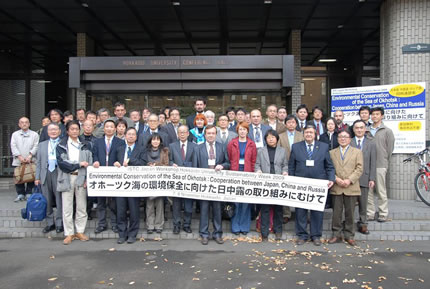

|
Top Page
Congress Information
JCREES News
Link Collection
JCREES Articles
Board Members
Secretariat
SRC website
JAREES: The Japanese Association for Russian and East European Studies Japan Association for the Study of Russian Language and Literature JSSEES: The Japanese Society for Slavic and East European Studies Japanese Society for the Study of Russian History JAIR; The Japan Association of International Relations JACES: Japan Association for Comparative Economic Studies JCAS: Japan Consortium for Area Studies ICCEES Newsletter |
International Symposium on “Environmental Conservation of the Sea of Okhotsk: Cooperation between Japan, China, and Russia” Shinichiro Tabata (SRC) An international symposium on “Environmental Conservation of the Sea of Okhotsk: Cooperation between Japan, China, and Russia” was held on November 7–8 as part of the Hokkaido University Sustainability Weeks 2009. Led by the Pan-Okhotsk Research Center, Institute of Low Temperature Science at Hokkaido University, the symposium was organized in cooperation with several institutions including the Slavic Research Center. International conferences on the theme of environmental preservation and conservation of the Sea of Okhotsk have been held since 2006 on a bilateral basis such as between Japan and Russia, or Japan and China. However, what made this international symposium groundbreaking was the participation of researchers from three countries, Japan, Russia, and China. Furthermore, the biggest achievement was the founding of the Amur-Okhotsk Consortium, an international network of scientists for intensive discussion on the future of the sustainable development in the Amur-Okhotsk region following the drawing up of a joint declaration.  Participants gathering in front of the conference hall Some of the speakers presented their findings based on the results of research conducted at the Institute of Low Temperature Science and the Research Institute for Humanity and Nature that clearly took into serious consideration and identified the significant role of the Sea of Okhotsk on fishery catches in the Pacific Ocean. Furthermore, several works revealed the critical function of the inflow from the Amur to the Sea of Okhotsk, while some emphasized that the relationship between the Sea of Okhotsk and Amur River should be called “the giant fish breeding forest” and preserved as a whole or as one system. Other participants pointed out that this kind of remarkable research and investigation have developed in line with the collaboration between Japan and Russia, China and Russia, and Japan and China, which is a result of the end of the Cold War and of the resolution of border conflicts between China and Russia. The establishment of the consortium owes much to this improvement in international relations. The “Joint Declaration by Researchers toward Environmental Conservation of the Sea of Okhotsk and Surrounding Regions” that has been adopted at the symposium includes the following main points: (1) consortium meeting should be conducted once every two years to exchange opinions and information; (2) while this marks the first meeting of such kind, a second meeting will be held in 2011 in Sapporo; (3) a provisional secretariat should be established at the Pan-Okhotsk Research Center, Institute of Low Temperature Science; and (4) the provisional secretaries appointed are Naoto Ebuchi (Institute of Low Temperature Science), Peter Baklanov (Pacific Institute of Geography of the Far Eastern Branch of the Russian Academy of Sciences), and Da Zhigang (Heilongjiang Provincial Academy of Social Sciences). This groundbreaking symposium will become a historical benchmark for the development of research regarding environmental conservation of the Pan-Okhotsk region. Slavic Research Center News No. 17, January 2010 |
[Secretariat] Slavic Research Center, Hokkaido University
Kita-9, Nishi-7, Kita-ku, Sapporo 060-0809 JAPAN
e-mail:src@slav.hokudai.ac.jp fax:+81-11-706-4952
copyright (c) 1998-2010 JCREES